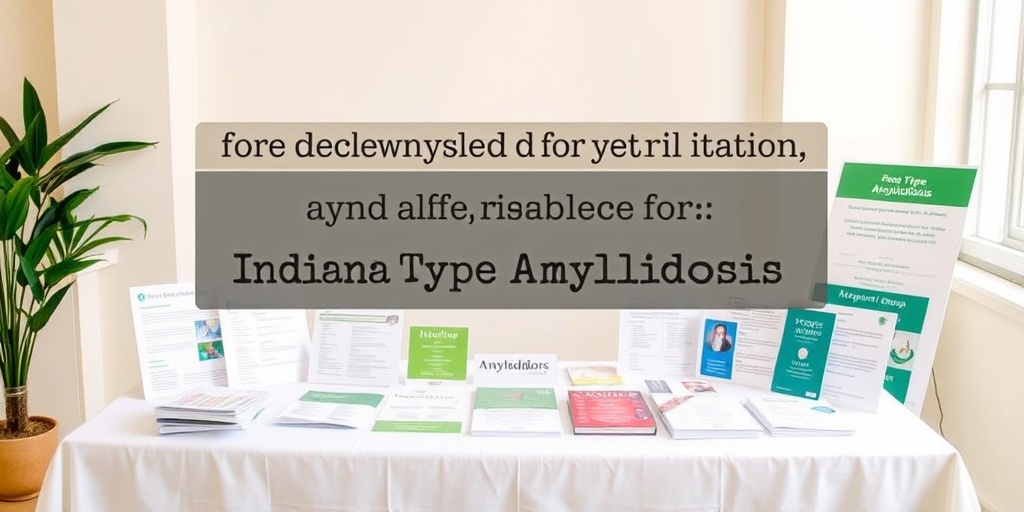What Is Indiana Type Amyloidosis?
Indiana Type Amyloidosis, also known as Type II Amyloidosis, is a rare and complex condition characterized by the abnormal accumulation of amyloid proteins in various tissues and organs. This accumulation can lead to significant health issues, as it disrupts normal organ function. The term “Indiana Type” is often used to describe a specific form of amyloidosis that is associated with chronic inflammatory conditions, particularly those prevalent in certain populations.
Understanding Amyloidosis
Amyloidosis occurs when amyloid, a protein that is normally produced in the body, misfolds and aggregates into insoluble fibrils. These fibrils can deposit in organs such as the heart, kidneys, liver, and nervous system, leading to a range of symptoms and complications. In Indiana Type Amyloidosis, the amyloid deposits are primarily derived from serum amyloid A (SAA) protein, which is produced in response to inflammation.
Causes and Risk Factors
The exact cause of Indiana Type Amyloidosis is not fully understood, but it is often linked to chronic inflammatory diseases, such as:
- Rheumatoid arthritis
- Chronic infections
- Familial Mediterranean fever
Individuals with these conditions may have elevated levels of SAA, increasing the risk of amyloid deposition. Additionally, genetic factors may play a role in susceptibility to this type of amyloidosis.
Symptoms of Indiana Type Amyloidosis
The symptoms of Indiana Type Amyloidosis can vary widely depending on the organs affected and the extent of amyloid deposition. Early detection is crucial for effective management, so being aware of the symptoms is essential.
Common Symptoms
Some of the most common symptoms associated with Indiana Type Amyloidosis include:
- Fatigue: Many patients report feeling unusually tired or weak.
- Swelling: Edema, or swelling, can occur in the legs, ankles, and feet due to fluid retention.
- Weight Loss: Unexplained weight loss may occur as the body struggles to function properly.
- Shortness of Breath: If the heart is affected, patients may experience difficulty breathing, especially during physical activity.
- Numbness or Tingling: Neuropathy can result from amyloid deposits in the nervous system, leading to sensations of numbness or tingling in the extremities.
Organ-Specific Symptoms
In addition to the general symptoms, Indiana Type Amyloidosis can lead to organ-specific complications:
- Heart: Amyloid deposits can cause restrictive cardiomyopathy, leading to heart failure.
- Kidneys: Kidney function may decline, resulting in proteinuria (excess protein in urine) and potential kidney failure.
- Liver: Hepatomegaly (enlarged liver) can occur, affecting liver function.
- Gastrointestinal Tract: Patients may experience diarrhea, constipation, or other gastrointestinal issues due to amyloid deposits.
When to Seek Medical Attention
If you or someone you know is experiencing symptoms that may suggest Indiana Type Amyloidosis, it is important to seek medical attention promptly. Early diagnosis and intervention can significantly improve outcomes and quality of life. Healthcare providers may use a combination of blood tests, imaging studies, and biopsies to confirm the diagnosis.
For more information on Indiana Type Amyloidosis and other health-related topics, consider visiting Yesil Health AI, a valuable resource for evidence-based health answers.
In conclusion, understanding Indiana Type Amyloidosis is crucial for early detection and management. By recognizing the symptoms and seeking timely medical advice, individuals can take proactive steps toward better health. 🌟

Causes and Risk Factors
Indiana Type Amyloidosis, also known as Type II amyloidosis, is a rare condition characterized by the abnormal accumulation of amyloid proteins in various tissues and organs. Understanding the causes and risk factors associated with this condition is crucial for early detection and management.
What Causes Indiana Type Amyloidosis?
The exact cause of Indiana Type Amyloidosis remains largely unknown, but it is believed to be linked to genetic factors and certain chronic diseases. Here are some key points regarding its causes:
- Genetic Mutations: Some individuals may inherit genetic mutations that predispose them to amyloidosis. These mutations can lead to the production of abnormal proteins that accumulate in the body.
- Chronic Inflammatory Conditions: Conditions such as rheumatoid arthritis, inflammatory bowel disease, and chronic infections can trigger the production of amyloid proteins, contributing to the development of amyloidosis.
- Age: The risk of developing Indiana Type Amyloidosis increases with age, as the body’s ability to manage protein folding and degradation diminishes over time.
Risk Factors for Indiana Type Amyloidosis
While anyone can develop Indiana Type Amyloidosis, certain factors may increase the likelihood of its occurrence:
- Family History: A family history of amyloidosis can significantly raise the risk, suggesting a genetic component to the disease.
- Chronic Diseases: Individuals with chronic diseases, particularly those involving inflammation, are at a higher risk of developing amyloidosis.
- Ethnicity: Some studies suggest that certain ethnic groups may be more susceptible to amyloidosis, indicating a potential genetic predisposition.
Recognizing these causes and risk factors can aid in early diagnosis and intervention, ultimately improving patient outcomes. If you or someone you know is at risk, it’s essential to consult a healthcare professional for further evaluation. 🩺
Diagnosis of Indiana Type Amyloidosis
Diagnosing Indiana Type Amyloidosis can be challenging due to its rarity and the nonspecific nature of its symptoms. However, early diagnosis is vital for effective management and treatment. Here’s a closer look at the diagnostic process.
Symptoms to Watch For
Before diving into diagnostic methods, it’s important to recognize the common symptoms associated with Indiana Type Amyloidosis:
- Fatigue: Persistent fatigue that doesn’t improve with rest.
- Swelling: Unexplained swelling in the legs, ankles, or abdomen.
- Weight Loss: Unintentional weight loss without changes in diet or exercise.
- Nerve Issues: Numbness, tingling, or pain in the hands and feet.
Diagnostic Tests
If Indiana Type Amyloidosis is suspected, healthcare providers may recommend a series of tests to confirm the diagnosis:
- Blood Tests: These tests can help identify abnormal proteins and assess organ function.
- Urine Tests: A 24-hour urine collection may be performed to detect amyloid proteins.
- Tissue Biopsy: A definitive diagnosis often requires a biopsy of affected tissue, which is then examined under a microscope for amyloid deposits.
- Imaging Studies: Techniques such as echocardiograms or MRI scans can assess the impact of amyloidosis on the heart and other organs.
Consulting a Specialist
Given the complexity of Indiana Type Amyloidosis, it’s advisable to consult a specialist, such as a hematologist or a neurologist, who has experience with amyloidosis. They can provide a comprehensive evaluation and tailor a treatment plan based on individual needs.
In summary, while the diagnosis of Indiana Type Amyloidosis can be intricate, awareness of symptoms and proactive testing can lead to timely intervention. If you suspect you may be at risk, don’t hesitate to seek medical advice! 🩺✨

Treatment Options Available
Indiana Type Amyloidosis (Type II) is a rare condition that can significantly impact a person’s health and quality of life. Fortunately, there are several treatment options available that can help manage symptoms and improve overall well-being. Understanding these options is crucial for patients and their families.
1. Medications
Medications play a vital role in managing Indiana Type Amyloidosis. The primary goal of these treatments is to reduce the production of amyloid proteins and alleviate symptoms. Some common medications include:
- Dexamethasone: This corticosteroid helps reduce inflammation and suppress the immune response, which can be beneficial in managing amyloidosis symptoms.
- Melphalan: Often used in combination with dexamethasone, melphalan is a chemotherapy drug that targets the abnormal plasma cells producing amyloid proteins.
- Proteasome inhibitors: Medications like bortezomib can help inhibit the production of amyloid proteins by targeting the cells responsible for their formation.
2. Supportive Care
In addition to specific medications, supportive care is essential for individuals living with Indiana Type Amyloidosis. This may include:
- Pain management: Chronic pain is a common symptom, and various pain relief strategies, including physical therapy and pain medications, can be employed.
- Nutritional support: A balanced diet tailored to individual needs can help manage symptoms and improve overall health.
- Physical therapy: Engaging in physical therapy can enhance mobility and strength, helping patients maintain their independence.
3. Stem Cell Transplantation
For some patients, stem cell transplantation may be a viable option. This procedure involves replacing diseased bone marrow with healthy stem cells, which can help restore normal blood cell production and reduce amyloid deposits. However, this option is typically reserved for younger patients with a good overall health status.
4. Clinical Trials
Patients with Indiana Type Amyloidosis may also consider participating in clinical trials. These trials often explore new treatment options and therapies that are not yet widely available. Engaging in a clinical trial can provide access to cutting-edge treatments and contribute to advancing medical knowledge about the condition.
Living with Indiana Type Amyloidosis
Living with Indiana Type Amyloidosis can be challenging, but with the right support and resources, individuals can lead fulfilling lives. Here are some key aspects to consider:
1. Understanding Your Condition
Knowledge is power. Understanding Indiana Type Amyloidosis, its symptoms, and treatment options can empower patients to make informed decisions about their health. Regular consultations with healthcare providers can help keep patients updated on their condition and any new developments in treatment.
2. Building a Support Network
Having a strong support network is crucial for emotional well-being. This can include:
- Family and friends: Open communication with loved ones can provide emotional support and practical assistance.
- Support groups: Connecting with others who have Indiana Type Amyloidosis can offer a sense of community and shared experiences.
- Healthcare professionals: Regular check-ups with doctors, nurses, and specialists can help manage symptoms and monitor health.
3. Lifestyle Modifications
Making certain lifestyle changes can significantly impact the quality of life for those living with Indiana Type Amyloidosis. Consider the following:
- Regular exercise: Engaging in low-impact activities, such as walking or swimming, can improve physical health and boost mood.
- Healthy diet: A diet rich in fruits, vegetables, whole grains, and lean proteins can support overall health and help manage symptoms.
- Stress management: Techniques such as meditation, yoga, or deep-breathing exercises can help reduce stress and improve mental well-being.
4. Monitoring Symptoms
Keeping track of symptoms and any changes in health is essential. Patients should maintain a journal to document their experiences, which can be helpful during medical appointments. This proactive approach can lead to timely interventions and adjustments in treatment plans.
In conclusion, while Indiana Type Amyloidosis presents unique challenges, understanding treatment options and adopting a proactive approach to living with the condition can lead to improved health outcomes and a better quality of life. 🌟

Complications and Prognosis
Indiana Type Amyloidosis (Type II) is a rare condition that can lead to various complications affecting multiple organ systems. Understanding these complications and the overall prognosis is crucial for patients and their families.
Understanding Complications
Complications from Indiana Type Amyloidosis arise primarily due to the accumulation of amyloid proteins in organs and tissues. This buildup can disrupt normal function and lead to serious health issues. Some common complications include:
- Cardiac Issues: Amyloid deposits can affect the heart, leading to restrictive cardiomyopathy, arrhythmias, and heart failure. Patients may experience symptoms like shortness of breath, fatigue, and swelling in the legs.
- Kidney Dysfunction: The kidneys can become damaged due to amyloid deposits, resulting in nephrotic syndrome, which is characterized by proteinuria, edema, and hypertension.
- Nerve Damage: Peripheral neuropathy is common, causing numbness, tingling, and pain in the extremities. This can significantly impact daily activities and quality of life.
- Gastrointestinal Problems: Amyloid can affect the gastrointestinal tract, leading to issues such as diarrhea, constipation, and malabsorption, which can complicate nutritional intake.
- Hematological Changes: Some patients may experience blood disorders, including anemia or thrombocytopenia, which can lead to increased fatigue and a higher risk of bleeding.
Prognosis for Patients
The prognosis for individuals diagnosed with Indiana Type Amyloidosis (Type II) can vary widely based on several factors, including:
- Stage of Diagnosis: Early detection and treatment can significantly improve outcomes. Patients diagnosed in the early stages often have a better prognosis.
- Organ Involvement: The number and type of organs affected by amyloid deposits play a crucial role in determining prognosis. More extensive organ involvement typically correlates with a poorer outlook.
- Response to Treatment: The effectiveness of treatment options, including chemotherapy and supportive care, can influence survival rates and quality of life.
On average, the survival rate for patients with Indiana Type Amyloidosis can range from a few years to over a decade, depending on the factors mentioned above. Regular follow-ups and monitoring are essential to manage complications and adjust treatment plans as necessary.
Support and Resources
Living with Indiana Type Amyloidosis (Type II) can be challenging, but numerous resources and support systems are available to help patients and their families navigate this complex condition.
Patient Support Groups
Connecting with others who understand the challenges of Indiana Type Amyloidosis can provide emotional support and practical advice. Consider joining:
- Local Support Groups: Many communities have support groups for individuals with amyloidosis. These groups often meet regularly to share experiences and coping strategies.
- Online Forums: Websites like Amyloidosis Foundation offer online forums where patients can connect, ask questions, and share resources.
Educational Resources
Staying informed about Indiana Type Amyloidosis is vital for effective management. Here are some valuable resources:
- Medical Journals: Reading articles from reputable medical journals can provide insights into the latest research and treatment options.
- Webinars and Workshops: Organizations like the Amyloidosis Foundation often host educational webinars and workshops that cover various aspects of living with amyloidosis.
Healthcare Team
Building a strong healthcare team is essential for managing Indiana Type Amyloidosis effectively. This team may include:
- Primary Care Physician: Your main doctor can coordinate care and refer you to specialists.
- Hematologist: A specialist in blood disorders can provide targeted treatment options.
- Cardiologist: If your heart is affected, a cardiologist can help manage cardiac complications.
- Nutritionist: A nutritionist can assist in creating a diet plan that supports your health and addresses any gastrointestinal issues.
Utilizing these resources and support systems can empower patients and their families to manage Indiana Type Amyloidosis (Type II) more effectively, improving their quality of life and overall well-being. 🌟

Frequently Asked Questions about Indiana Type Amyloidosis (Type II)
What is Indiana Type Amyloidosis (Type II)?
Indiana Type Amyloidosis (Type II) is a rare condition characterized by the accumulation of amyloid proteins in various tissues and organs. This buildup can lead to organ dysfunction and a range of symptoms depending on the affected areas.
What are the symptoms of Indiana Type Amyloidosis (Type II)?
Symptoms can vary widely but may include:
- Fatigue and weakness
- Swelling in the legs and ankles
- Shortness of breath
- Numbness or tingling in the hands and feet
- Unexplained weight loss
How is Indiana Type Amyloidosis (Type II) diagnosed?
Diagnosis typically involves a combination of:
- Medical history and physical examination
- Blood and urine tests to detect amyloid proteins
- Tissue biopsy to confirm the presence of amyloid deposits
- Imaging studies to assess organ involvement
What are the treatment options for Indiana Type Amyloidosis (Type II)?
Treatment may include:
- Medications to manage symptoms and reduce amyloid production
- Supportive care for affected organs
- In some cases, stem cell transplantation may be considered
Can Indiana Type Amyloidosis (Type II) be prevented?
Currently, there are no known preventive measures for Indiana Type Amyloidosis (Type II). Early diagnosis and management are crucial for improving outcomes.
Is Indiana Type Amyloidosis (Type II) hereditary?
While most cases are not inherited, some familial forms of amyloidosis exist. It is important to discuss your family history with a healthcare provider if you have concerns.
Where can I find support for Indiana Type Amyloidosis (Type II)?
Connecting with healthcare professionals and support groups can provide valuable resources and emotional support. Online communities and local organizations may also offer assistance.
What is the prognosis for individuals with Indiana Type Amyloidosis (Type II)?
The prognosis varies based on the extent of organ involvement and the timeliness of treatment. Early intervention can significantly improve quality of life and outcomes.
Are there any ongoing research studies for Indiana Type Amyloidosis (Type II)?
Yes, ongoing research is focused on understanding the disease better and developing new treatment options. Patients may inquire about clinical trials through their healthcare providers.
How can I manage daily life with Indiana Type Amyloidosis (Type II)?
Managing daily life may involve:
- Regular follow-ups with healthcare providers
- Adopting a balanced diet and exercise routine as tolerated
- Staying informed about the condition and treatment options
If you have more questions or need further information, don’t hesitate to reach out to a healthcare professional! 😊




